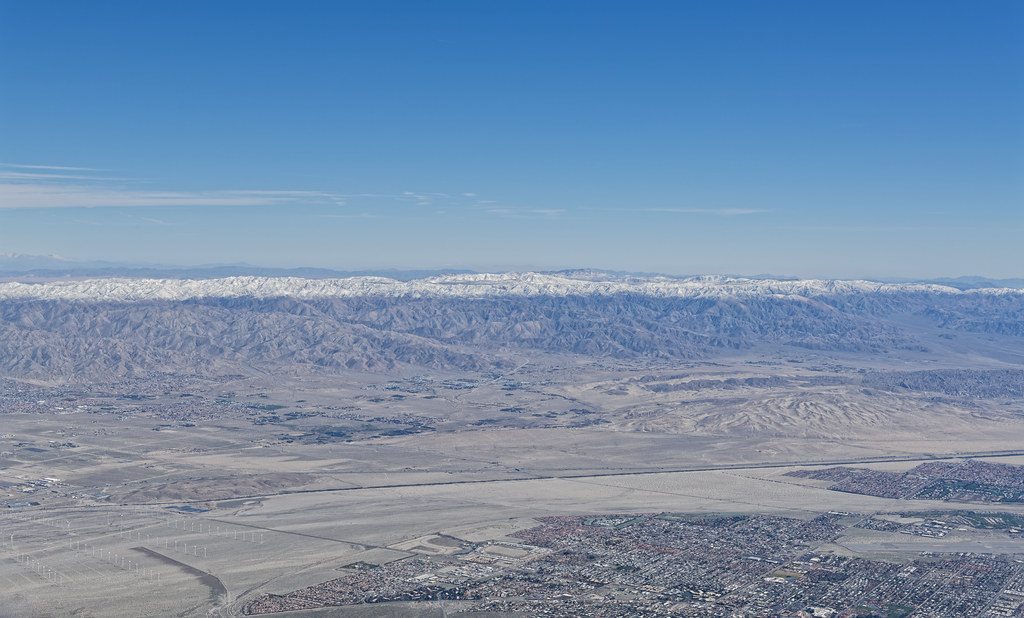#Central and Southern California Ranges
Video
Stopping by to See Some Woods on a Snowy Morning in the San Jacinto Mountains by Mark Stevens
Via Flickr:
A setting looking to the southwest while taking in views at the Palm Springs Aerial Tramway Mountain Station and across a snowy landscape with a forest of evergreen trees. This is in Mount San Jacinto State Park.
#Azimuth 208#Blue Skies#Central and Southern California Ranges#Day 3#Desert Mountain Landscape#Divide Peak#DxO PhotoLab 6 Edited#Joshua Tree National Park and California#Landscape#Landscape - Scenery#Looking SW#Luella Todd Peak#Marion Mountain#Mount San Jacinto State Park#Mountain Peak#Mountain Station#Mountains#Mountains in Distance#Mountains off in Distance#Mountainside#Nature#Nikon D850#No People#Outside#Pacific Ranges#Palm Springs Aerial Tramway#Peninsular Southern California Ranges#Project365#Ridge#Ridgeline
2 notes
·
View notes
Text
Imagine that a century or two from now, the eastern half of the United States is conquered by the Canadian Empire, its intelligentsia deported, its land colonized by Canadian immigrants, and its remaining people mostly gradually absorbed into a Neo-Canadian identity. The West reorganizes, developing a new political and cultural center, and comes to regard itself as the "true" United States, with the remnant culture of the East (by now much changed by Canadian rule) as representing an unchanged tradition stretching back to the time of George Washington. The holdout western half is subsequently conquered by the Reformed Mexican Empire, and while most of the population remains in situ, its elite is taken to Mexico City. There, for three or four generations, they do their best to maintain their distinct American identity, focusing on the American "civil religion," the distinctive political ideals and cultural features that mark them out as Americans, and come up with a new way of interpreting their history that allows America to be a perennial idea, something not directly physically tied to the territory of the United States, which no longer exists. They compose a body of historical works based on Washington Irving's rather fabulistic approach to early American history, the half-remembered popular versions of the stories of Columbus and the Pilgrims, the First Thanksgiving, even the Revolutionary War. They don't have access to the original texts anymore--let's say this is all taking place in a post-Collapse North America where long-range travel and communication is difficult and a lot of history has been lost--but they do their best. They append to these books, or include in their text, of history a copy of the Constitution, big chunks of the United States Code, and Robert's Rules of Order.
Subsequently, the Empire of Gran Columbia invades, conquers southern and central Mexico, and its Emperor lets the captive Americans go home. They return north, mostly to California, find that the version of American history and civics that is remembered there isn't the same as the version they have (not that the Californian one is correct--the Mexican Empire has suppressed English-language education and high culture in its Aztlani provinces), and set about reforming and reorganizing the Western States (as they're now called) to be more in line with the forms they brought back from the exile. In the meantime, other bits of important literature start being kept in libraries next to copies of the received histories: some bits of early American literature, like Hawthorne, the Song of Hiawatha, some highly abridged Herman Melville, Thomas Paine--heck, even some John Locke, and quotes or fragments from Shakespeare. Some traditionalists now argue the capital of the United States has always been located in San Francisco, and that Washington, D.C. only because the capital later, under the influence of Eastern heretics.
In the following centuries, the Western States retain their independence for a time, but eventually become a secondary battleground for a lot of other empires--the Mexicans, the Canadians, the Pan-Pacific Federation, and so forth. American culture remains distinctive, insulted in part by its unique traditions, though now everybody speaks Future Spanish, and only learns English to read the old texts. In this period additional material, including later compositions, continues to accrete, forming a distinct body of sacred American scripture, although it does not exist in a single canonical form. Attempts to reconcile distinct sources, like more literal and historically-grounded accounts versus the simplified narratives of figures like Irving, produce hybrid texts that sometimes are full of internal conflicts.
Oh, and through all this, some institutions of American government like the Supreme Court still function, although their rulings only apply to Americans, and there isn't much in the way of a federal bureaucracy.
Finally the Great and Sublime Brazilian Potentate conquers most of the Americas, sets up an American client state that roughly coincides with the heartland of the old Western States (California, Oregon, most of Washington and Nevada), and allows the Americans to elect their own President (subject, of course, to Brazilian approval). During this period, an apocalyptic street preacher from Los Angeles claims to have inherited the authority and power of George Washington, and is executed by the Brazilians; his later followers point to the prophecies of Emperor Norton, and out-of-context bits of a Quebecois translation of Moby-Dick and some Mark Twain stories to say no, really, he was George Washington. Inexplicably, a version of this religion becomes the dominant faith of the Brazilian Empire before it collapses. But long before then the American state in California fails, crushed when it tries to revolt against Brazilian rule; the remnant Easterners likewise dwindle down to only a few hundred souls living in a village in Alexandria, Virginia. Centuries from now, as the descendants of the descendants of the Brazilians colonize Mars, they will point to the sacred Americanist scriptures, the Neo-Americanist narratives of their prophet's life, and the letters written by the early leaders of Neo-Americanism, and say, "all of this was written by the spirit of George Washington, and is free from contradictions." Meanwhile the remnant Americanists, who have been writing about Americanism and how it applies to their everyday lives in the centuries since, and whose commentary has formed around the copies of the last editions of the U.S. Supreme Court Reporter (SCOTUS managed to outlast the final American state by a hundred years or so) plus the thoughts of the remaining Americanist community in Mexico, continue to regard their traditions as the unbroken and unaltered practice of American culture, politics, and ideals as they existed since the Revolutionary War.
This is, as far as I can tell, approximately how the Bible was composed.
1K notes
·
View notes
Text
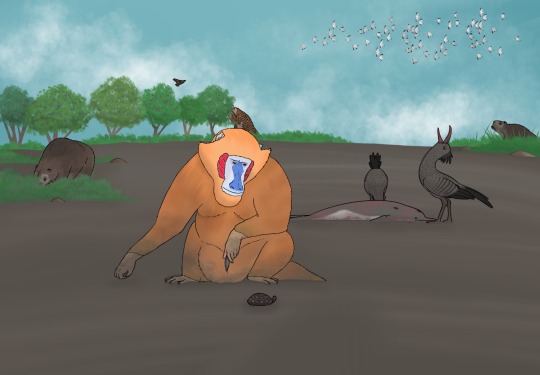
In the Anectyocene North America is one of the most biodiverse continents, thanks to the extreme variety of biomes, and having a biosphere much more different than the rest of the world. Its ten million years isolation from Afro-Eurasia, and partial isolation from South America, thanks to both mountains and the rainforest not allowing bigger pampas and chaco dwellers to reach the northern continent, allowed it to develop much more distinct ecosystems.

One of the most diverse and common clades in the continent are Lepolopidae, walking or running jackrabbits inhabiting both the grasslands, the redwood forests in the west and the humid forests in the east, that diverge in many ways from their Eurasian cousins.
They’ve developed antlers instead of tusks (or horns in some cases), and evolved their outermost toes into opposable and semi-opposable digits, allowing them to become quite skilled climbers, letting them browse on trees regardless of their height, and helping them escape from land dwelling predators.
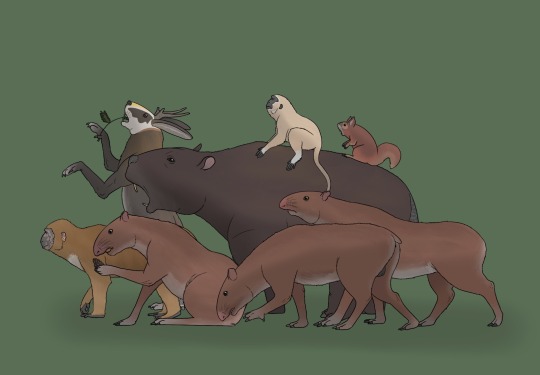
Another quite diverse group of herbivores are the Mayarrhinidae, agouti descendants that came from Central America and expanded into the rest of the continent, that consume almost every kind of plant matter and are quite important seed dispersers of evergreens and oak-trees.
The most important seed dispersers of the continent, tho, are monkeys, especially macaques, whose expansion northwards allowed the expansion of many plants descended from feral fruit producing species.
North American monkeys are all descended from four ancestral introduced species: squirrel monkeys, capuchins, crab eating macaques and rhesus macaques. The first two are for the most part limited to Florida, and on a lesser degree the denser parts of the southern US’ forests, while the two macaques have an almost continent-wide range, going from British Columbia to Sinaloa, and from California to Newfoundland. Thanks to the absence of primates in these areas these macaques have been able to undergo an adaptive radiation, giving life to the polyphyletic group of the New World macaques (Bibliopithecinae, for the rhesus descendants, and Galactopithecinae, for the crab-eater descendants), and resulting in a myriad of forms resembling baboons, geladas, tamarins (that in some cases even compete with squirrels) and apes.
Many changed diets, becoming grazers, leaf eaters and in one case molluscivorous. The Cyonuropithecus caelurorrhinus is a Galactopithecine part of a gelada like genus inhabiting the areas of the Atlantic coast of Canada and the Northern US. Although the other members of its genus are for the most part grazers their diet is mainly made up of molluscs and crabs that they found on the shore with low tide. For this lifestyle they evolved naked hands and wrists and a stronger bite force. They’re also some of the best primate swimmers, thanks to their partially webbed hands.
Some of the biggest herbivores of the continent evolved from beavers, the biggest surviving rodents, that would become as big as hippos and rhinos, and would graze on the bushes and grasses on the ground. The actual biggest land animals, tho, are the ground porcupines, that came from South America, and being generally good rainforest dwellers were able to pass through Central America with ease.
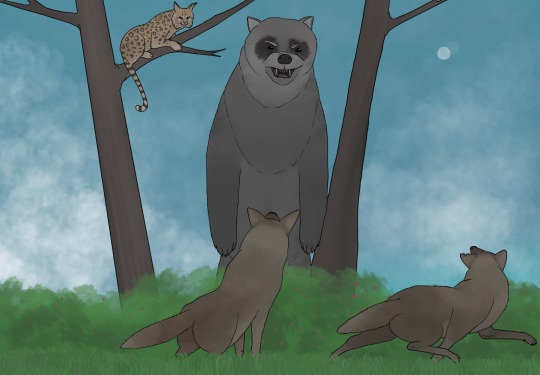
The predators of North America, though, are what really set it apart from the rest of the world, being the only continent, not counting islands like Madagascar, without a mammalian apex predators. Like South America during most of the Cenozoic the continent’s hypercarnivores are birds, more specifically caracara descendants, whose only competitors are the Diacyonines, bear-like raccoon descendants with an omnivorous diet. The other main predatory clades of the continent are the Latrantocyonines, wolf analogues descended from coyotes, and partially from dogs too, the Lycornithines, roadrunners that mainly scavenge and hunt small game, and Bizofelines, descendants of domestic cats that are now arboreal lynx like hunters, and effective mountain dwellers too.
https://discord.gg/KjusGndh discord link if u wanna join the project’s server
#spec evo#spec bio#speculative evolution#speculative biology#artwork#worldbuilding#digital art#epigene period#future earth
15 notes
·
View notes
Note
What's that one fact that never comes up in conversation naturally but you're desperate to talk about
I over thought tf out of this bc there's so much!!
But one thing that was on my mind recently is why the Coast Redwood's range is restricted on the northern end. It seems like it shouldn't be. Why?
For context, the Coast Redwood lives on the Pacific Coast of California, from Big Sur in central California to juuusssttt barely over the border with Oregon. They primarily thrive in the wet Northwest corner of the state, which is temperate rainforest. This is where the tallest trees in the world grow, in Redwood National Park.
But you get a little north of that, and their range ends. Completely. They get taller and healthier with more rain, and as you go North, it only gets rainier. Other trees thrive in this environment, and will grow to 200-300ft high because of it, but none reach the 300-400ft heights of the redwoods in Humboldt county. So why does the range end?
Anyone familiar with redwoods will be familiar with the key ingredient that makes them special: coastal fog. Redwoods, unlike most trees, harvest water from the entirety of their trunk and leaves, as opposed to evaporatively pumping all their water from their roots. This means they can "cheat" and break the normal height limits of trees, because water doesn't have to travel up their entire height for it to be available at the top.
What I *think* is going on with the northern range limit is this (still just a guess tbf): the extra rain is actually indicative of less fog, since coastal clouds make it to higher elevations before reaching a dew point. So, while there's more water available to the ecosystem as a whole, less is available to the redwoods specifically, cutting off their range in southern Oregon.
Idk if this was interesting in the slightest, but it was a fun little thought experiment for me, so I hope you enjoy!
42 notes
·
View notes
Text
Terrifying Alien-like creature with 20 Arms has been discovered in the Antarctic Ocean. Meet the Antarctic Strawberry Feather Star, a new species with 20 arms and a fruity shape. This large creature lives in the deep and cold waters of the Southern Ocean. It can be purplish or dark reddish in color.
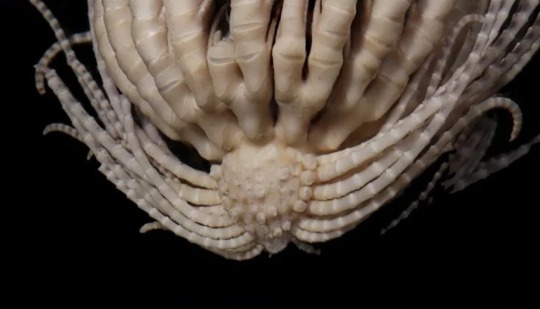
The Antarctic Strawberry Feather Star is a new species of marine animal that belongs to the genus Promachocrinus, a group of invertebrates related to starfish and sea cucumbers. It was discovered by scientists from the Scripps Institution of Oceanography and the University of California, San Diego, who conducted several expeditions to the Southern Ocean between 2008 and 2017.
The Antarctic Strawberry Feather Star has a unique shape and appearance that resembles a strawberry with 20 arms. Its central body, or calyx, is round and flattened, with a diameter of about 10 cm. Its arms are long and slender, reaching up to 30 cm in length. The arms are covered with small projections called pinnules, which help the animal filter food from the water. The color of the animal can vary from purplish to dark reddish, depending on the depth and light conditions.
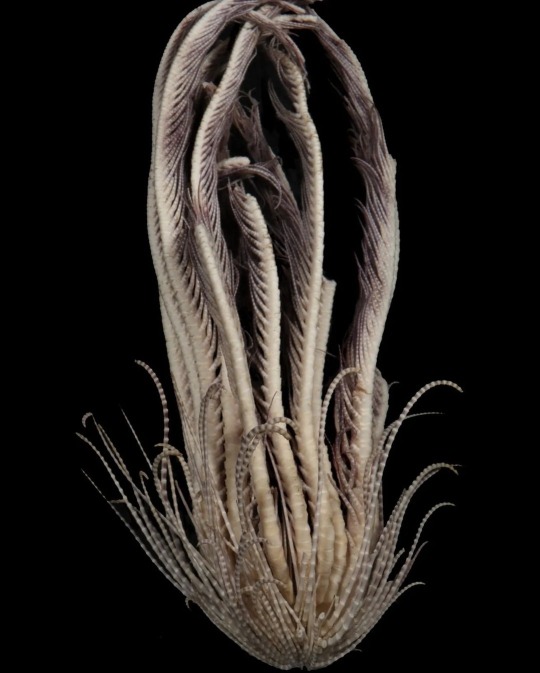
The Antarctic Strawberry Feather Star lives in the deep and cold waters of the Southern Ocean, at depths ranging from 65 to 6500 feet. It is usually found attached to rocks or other hard substrates by a stalk-like structure called a cirrus. The animal can also detach itself and swim by waving its arms. It feeds on plankton and other small organisms that it captures with its pinnules.
The Antarctic Strawberry Feather Star is one of four new species of Promachocrinus that were identified by the scientists, along with seven other known species. The researchers used DNA analysis and morphological examination to distinguish the different species. They also named the new species after their distinctive features or locations. For example, Promachocrinus fragarius means “strawberry-bearing” in Latin, while Promachocrinus rossi is named after explorer Sir James Clark Ross, who led the first expedition to Antarctica in 1839.
The discovery of the Antarctic Strawberry Feather Star and its relatives is an example of the rich and diverse biodiversity that exists in the Southern Ocean. The scientists hope that their research will help increase our knowledge and appreciation of this unique and fragile ecosystem. 🙏
34 notes
·
View notes
Text
February 8th, 2024

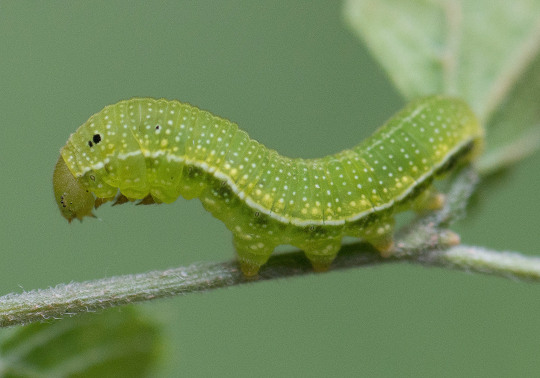
American Snout Butterfly (Libytheana carinenta)
Distribution: Found from Argentina to the southern USA, including Mexico and the West Indies. Migrates to the eastern USA, as far north as the Great Lakes region, as well as to central California, southern Nevada and Colorado.
Habitat: Usually found in forest clearings and edges, brushy fields, thorn scrub and roadsides.
Diet: Adults feed on nectar; common hosts include dogbane, aster, dogwood, goldenrod, sweet pepperbrush, etc, with a preference for white or yellow flowers. Larvae feed on the young foliage of hackberry trees, especially the common hackberry tree.
Description: The American snout butterfly's nose is actually its mouthparts, called labial palps. These elongated mouthparts are used in camouflage, as the butterfly will rest with its head pointed downwards, its snout imitating the petiole of a dead leaf.
These butterflies are migratory. Their native range includes the majority of South and Central America, as well as the southern USA; they travel northwards, sometimes in such large numbers that they darken the sky. These migrations are thought to be triggered by droughts, which pose dangers for the butterflies in the form of parasitoids and limited food sources. Inversely, the presence of heavy rain usually prompts a large amount of egg-laying, causing populations explosions.
Images by Sara Bright.
17 notes
·
View notes
Text
Warbler Showdown; Bracket 7, Poll 3
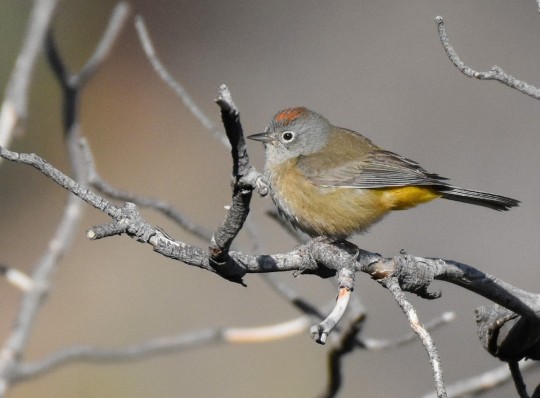

Colima Warbler (Leiothlypis crissalis)
IUCN Rating: Least Concern
Range: migratory; breeds in the Chisos Mountains in southwest Texas through the range in Mexico; overwinters in south central Mexico, from southern Sinaloa down to Oaxaca, though typically found in Colima and Morelos
Habitat: breeds in oak, Mexican pinyon, juniper, and Arizona cypress chaparral and overwinters in semihumid to humid montane forests.
Subspecies: none
Orange-crowned Warbler (Leiothlypis celata)
IUCN Rating: Least Concern
Range: migratory; breeds from Alaska to Newfoundland, all the way down to New Mexico, Arizona, and Baja California; overwinters in all southern states, along the Pacific Northwest, and in a majority of Mexico.
Habitat: breeding habitat is incredibly various due to range- brushy deciduous, fir-aspen, or pine-oak woodlands, harvested forests, and early-successional deciduous stands. Each of these habitats are associated with different tree types too, a true generalist. Overwinters in similar habitats.
Subspecies: 4
Image Sources: Colima (Jason Vassallo) OCWA (Matt Davis)
#NWW Showdown#colima warbler#orange crowned warbler#leiothlypis#parulidae#passeriformes#animal poll#bird poll#polls#(i kno they're boring and not gonna win but I have a soft spot for OCWA bc of banding)
13 notes
·
View notes
Text
How to Identify Trailing Blackberry
Originally posted on my website at https://rebeccalexa.com/how-to-identify-trailing-blackberry/. Click here to learn more about the How to Identify article series.
Name: Trailing blackberry (Rubus ursinus), also known as California blackberry, Pacific blackberry, Pacific dewberry, and a number of other common names.
Range and typical habitat(s): West coast of North America from southern British Columbia to northern Baja California, east to the Cascade mountains, and scattered through the Rocky Mountains in Idaho, Washington, and Montana.
Distinguishing physical characteristics (size, colors, overall shapes, detail shapes): Summer is here, and that means blackberries are ripening on the vine! Here in the Pacific Northwest where I live we have multiple species, all featuring delectable, juicy berries, but only one is native. The trailing blackberry distinguishes itself through a slender, biennial vine, pale green to bluish-purple in color, with tiny thorns all along its length. (Be careful when handling this vine, as the thorns easily detach and become embedded in your skin!) Some vines may exceed six feet in length, and each plant may produce several of these from a central perennial root system.
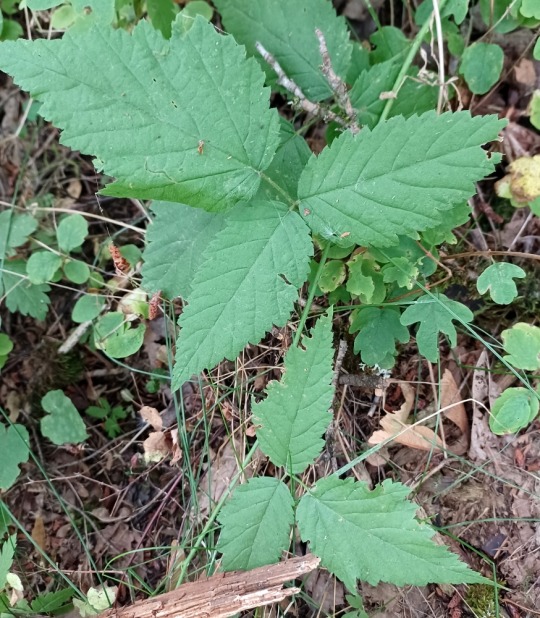
The leaves of trailing blackberry generally have three leaflets, though one or five may occasionally be seen, and they are dark green above with a pale green to white underside. Each leaflet is oval in shape with a pointed tip and a deeply serrated edge that has larger serrations interspersed with groups of smaller, finer serrations, and generally will not reach more than about four inches in length. This species is deciduous, and loses its leaves over winter before growing new foliage in the spring.

First-year vines are not fertile; they will not produce flowers until their second year, after which they die. Like many other Rubus species, it has a flower with five white petals that rarely exceeds an inch in diameter, and the petals are particularly slender compared to others in the genus. The center is pale green to yellow with several dozen anthers on the flowers of male plants. Female plants, of course, are the only ones to bear small berries about 3/4″ or so long at the largest, which start out green, darken to red, and finally ripen at a deep purple to black. While smaller than commercially available blackberries, they are quite sweet and flavorful when ripe. Technically they are not true berries, but are instead composites of several tiny round drupelets each with its own seed, which is typical of Rubus fruit.
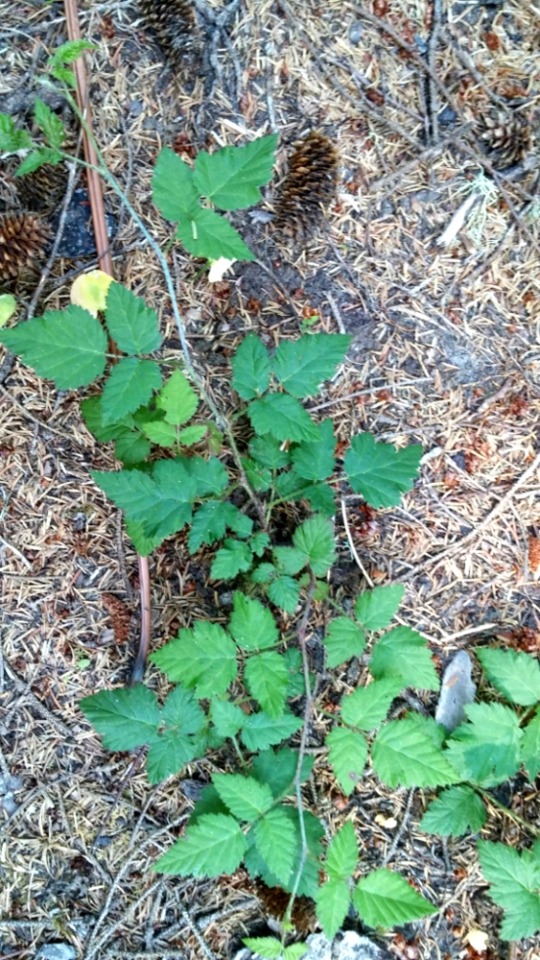
Trailing blackberry can grow quite quickly, and although it may clamber over other plants it generally does not out-compete them to the point of becoming a monoculture. It is also a quite hardy plant and can colonize disturbed ground with ease as long as there is plenty of sunlight. The vines can become a bit of a tripping hazard in places with high foot traffic, but are easily trimmed back without killing the entire plant. In addition to seeds, trailing blackberry can also grow colonies of clones wherever its vine touches the ground.
Other organisms it could be confused with and how to tell the difference:
In its native range, trailing blackberry is a rather unique little plant. It may occasionally be confused with the invasive Himalayan blackberry (Rubus armeniacus). However, the latter grows on large, thick canes up to thirty feet long that can grow tall and arch over, and which create massive thickets that choke out any other plant life. The leaves of Himalayan blackberry are also larger and rounder–up to eight inches long–and more typically have five palmately compound leaflets instead of three, though three leaflets may sometimes be seen. The flowers have rounder petals, and the berries are much larger, sometimes exceeding an inch in length.

Cutleaf or evergreen blackberry (Rubus laciniatus) is another invasive species found within trailing blackberry’s range. Like Himalayan, the cutleaf species also grows thick, long canes. It is mainly distinguished by its leaves, which have three leaflets that are deeply serrated/toothed and have a jagged appearance–hence the name “cutleaf.”

Black or whitebark raspberry (Rubus leucodermis) has berries which superficially look like those of trailing blackberry. However, once again the canes of this species are thicker and woodier than the trailing vines, and they have a distinctive white to pale purple glaucous coloration. The leaflets are larger than those of trailing blackberry, with first-year leaves having five pinnate leaflets, and second-year having three. The berries are larger and rounder, generally not exceeding 1/2″ in diameter. The overall appearance of the plant is of a taller, more upright shrub than a series of vines trailing over ground and other surfaces.

Anything else worth mentioning? Like other Rubus species, the berries of trailing blackberry are edible, and the leaves may be made into tea. If cultivating this species in your native plant garden, be aware it grows quite quickly, though it can be trained up a trellis with some effort.
Further reading:
Rubus ursinus – Trailing Blackberry
Rubus ursinus – Trailing blackberry; Dewberry; Pacific blackberry
Trailing Blackberry – Rosales Rosaceae Rubus ursinus
Trailing Pacific Blackberry
Did you enjoy this post? Consider taking one of my online foraging and natural history classes or hiring me for a guided nature tour, checking out my other articles, or picking up a paperback or ebook I’ve written! You can even buy me a coffee here!
#blackberries#berries#foraging#plant foraging#edible wild foods#plants#gardening#native plants#invasive species#invasive plants#Pacific Northwest#PNW#food#plant identification#nature identification
32 notes
·
View notes
Text
To my knowledge, there aren’t any fan-created cities in the Bioshock fandom….
Hidden deep in the mountains, a lighthouse stands as a beacon for all who seek the catacombs of Elysium.
Hello! I see that the mysterious hook has caught your attention! I’ve had an idea for a fan-created bioshock city for a while and would like to share the inklings and my thought process for a while.
If you’d like to, I’d love critique, feedback, etc on the ideas here.
While we know that there is always a man and a lighthouse, there were other categories I wanted to fulfill when creating this city and what I have for each:
A Man
As well as other interesting and important characters
Hook before a lighthouse- introduce the character.
Vaguely mid to young 20s, possibly a community college student, either likes urban exploration/ found footage content or is a hiker (possibly both)- something that would get him involved.
A Lighthouse
Nestled deep in the mountains, along a small pond and surrounded by ancient trees is a mysterious lighthouse that once stood as a beacon of hope but has not been seen in hundreds of years.
A City
The rise and fall of this civilization.
Elysium is a city underground in the southern Sierra Nevada range, roughly central to southern California.
The aesthetic of this one is inspired by underground cities found in Turkey, Etruscan tombs, and the Parisian catacombs.
Aesthetically, Rapture is cold and dark, Columbia is warm and bright, Polaris seems like it's going to be cold and bright. Elysium is warm and dark with materials like warm tuff, terra cotta, that sort of thing. Everything isn’t far off of being sepia toned, like aged paper.
A Time Period
Neither the golden age of the city nor game setting are modern day
The Golden Age: 1780s or so, Game Setting: roughly 2008-2014- the furthest back in time and closest to modern
A group of people unhappy with the newborn America leaves and finds a new home westward.
The architecture of the city is closely tied to some sort of inspiration from American history.
Neoclassical Architecture (all of the original government buildings and monuments in DC and such as well as historical homes like Monticello)
An Ideology
Showing the flaws of the ideology it was based on.
Everything connects to it.
There's some sort of critique of America and humanity.
This one would be centered on the Ancient Roman ideals that America pulled inspiration from.
Another main theme would be the value that people put in the past and the romanticizing and glorification of time periods long gone.
An Adam/ Lutece Particles parallel
Something similar to vigors and plasmids created from this parallel
Mutation/ mutated people caused by this.
The founders of this city settle here because they find a fruit/ berry that, when consumed, grants them immortality (although twisted). When the fruit is turned to wine with various additives, it gives them remarkable powers.
This is a reference to both the way that wine and intoxication was seen as divine and in the whole ‘eating the fruit of the dead’ sort of thing.
Some effects/ consequences of this process are being able to mold the self like clay to fit perfect mathematical beauty found in sculptures. Some are fused to the very walls of the caves as their world decays and they become an archeological dig in and of themselves, still alive but…
27 notes
·
View notes
Photo
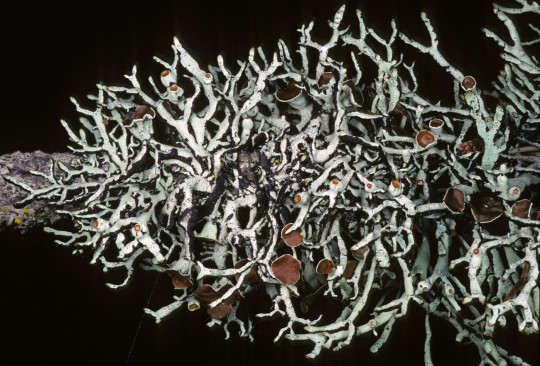
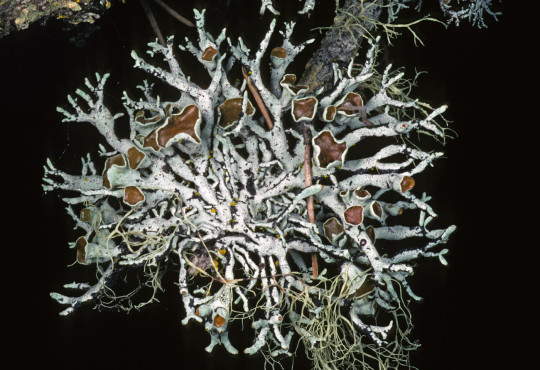






Hypogymnia heterophylla
Seaside bone lichen
My favorite thing about Halloween? Skeletons! I love skeletons, I love bones, I love skulls, I love memento mori, I love the complexity of millions of years of evolution and ecology and the cycle of life and death and returning to nature and uh! It just gets me. But, obviously, liches don’t have a skeleton, or bones. So I will just have to settle for lichens that vaguely look like bones to get my spooky-scary-skeleton-lichen Halloween fix! H. heterophylla is a foliose-fruticose lichen that can only be found on the Pacific coast of North America. It has long, inflated, cartilaginous lobes with irregular branching patterns. The upper surface is pale gray or gray-green, and perforated with small black pores (pycnidia). The edges of the thallus are black, as is the perforated lower surface. It produces short-stalked, urn-shaped apothecia with a concave brown disc. H. heterophylla grows on conifer bark in coastal habitats ranging only from southern British Columbia down to central California. Due to its limited range, it is considered a threatened species in Canada, and action plans for conservation are in place for the 7 colonies present there. If the thought of losing a beautiful friend like this to climate change and urbanization doesn’t scare you, I don’t know what will!
images: source | source | source
info: source | source
#lichen#lichenology#lichenologist#lichenized fungus#fungus#fungi#mycology#ecology#biology#botany#not plants#bryology#systematics#taxonomy#life science#environmental science#Hypogymnia heterophylla#forest#forestry#see the forest for the lichens#I'm lichen it#Hypogymnia#lichen a day#daily lichen post#trypo#trypophobia#nature#naturalist#natural science#beautiful nature
127 notes
·
View notes
Text

The ultimate vulture showdown! Accipitridae vs Cathartidae! Our bone-eating fashionista vs a giant in the process of an incredible comeback!
Bearded vultures seem to have achieved Tumblr fame, and just how much fame that is will be put to the test in this bracket! These vultures have a wide but sparse distribution across Eurasia, occurring in Spain, Morocco, East and Southern Africa, and Western and Central Asia. They greatly prefer mountainous regions. They weigh 4.5–7.8 kg (9.9–17.2 lb) and have wingspans of of 2.31–2.83 m (7 ft 7 in – 9 ft 3 in). Their plumage appears red or orange, but is actually naturally white. They achieve these bright colors by preening colorful dirt into their feathers, and the color is theorized to be a status symbol. Females, which are larger and more dominant, are more brightly dyed. Bearded vultures’ diets are up to 90% bone; it is mostly chicks that eat skin and meat. Adults can crack bones up to the size of a lamb’s femur with their powerful beaks, and break larger ones by dropping them on rocks. They are considered Near Threatened overall but are heavily endangered in Europe due to habitat loss, collisions with power lines, poisoning, and hunting.
California condors are currently extant in the southeast United States, though their range formerly extended from the northwestern US through northern Baja California in Mexico. They live in shrublands and forests, especially near rock cliffs. Their wingspan ranges from 2.49 to 3 m (98-118 in) and their weight from 7-14.1 kg (15-31 lb). A condor may travel 250 km (160 mi) in one day while scavenging! Since they have a very poor sense of smell, they find carrion by watching other scavengers. These condors have a social hierarchy within groups, with older birds being dominant over younger ones. While still critically endangered, they are in the process of a famous comeback—where once they were extinct in the wild with 22 captive birds in 1987, there are now 537 of these condors, 336 in the wild.
77 notes
·
View notes
Video
Across the Coachella Valley to Snow Capped Ridges and Peaks in Joshua Tree National Park by Mark Stevens
Via Flickr:
While at the Palm Springs Aerial Tramway (Mountain Station) with a view looking to the northeast.
#Azimuth NE#Blue Skies#Central and Southern California Ranges#Coachella Valley#Day 3#Desert Mountain Landscape#DxO PhotoLab 6 Edited#Joshua Tree National Park#Joshua Tree National Park and California#Joshua Tree Ranges#Landscape#Landscape - Scenery#Little San Bernardino Mountains#Looking 35#Mount San Jacinto State Park#Mountain Peak#Mountain Station#Mountains#Mountains in Distance#Mountains off in Distance#Mountainside#Nature#Nikon D850#No People#Outside#Pacific Ranges#Palm Springs Aerial Tramway#Peninsular Southern California Ranges#Project365#Ridge
2 notes
·
View notes
Text
Crocodile news.
December 2022: Dramatic crocodile appearance at Melbourne Beach in Florida, “the farthest north that the American crocodile has ever been documented” (at least on the Atlantic coast of the American continents).


Excerpt:

A rarely seen American crocodile has been documented in Central Florida, and it counts as one of the northernmost sightings ever reported. The crocodile was seen Sunday, Dec. 4, in Brevard County, about 75 miles southeast of Orlando. It was reported by the Brevard County Environmentally Endangered Lands Program, which called the encounter a “rare sighting” that far north. “American crocodiles typically live in coastal areas throughout the Caribbean, and southern Florida is at the very north end of their range,” the program post Dec. 5 on [social media]. The 8-foot reptile was found “relaxing on the beach in front of the Barrier Island Center” in Melbourne Beach, officials said. [...] The sighting comes one month after [a resident] [...] of Sebastian, Florida, shared video of another unexpected crocodile encounter, just 25 miles south [...]. Only 1,500 to 2,000 adult American crocodiles survive in southern Florida’s brackish swamps, the state says. The southern end of Brevard County is believed to be the farthest north the species has been documented [...].
---
Headline, image, caption, and text published by: Mark Price. “Rare American crocodile discovered much farther north than expected in Florida.” Miami Herald. 7 December 2022.
---
For context, here’s a map of records of the American crocodile (Crocodylus acutus). Their actual distribution range is now much more limited, since the crocodile has been eliminated from much of this habitat, especially in Ecuador, the coast of Colombia, Hispaniola in the Caribbean, and along the Pacific coast of Guatemala and Mexico.

This may be the farthest north that the American crocodile has been recorded in the Atlantic, but on the Pacific coast, the same crocodile species currently lives at several sites near Los Mochis on the coast of the Gulf of California in the Mexican state of Sinaloa. The crocodile has also been reported as recently as 2016 near the lower Yaqui river in Sonora, and in 1973 a crocodile was captured at El Ciego estuary near Guaymas. The Comcaac/Seri people have also reported crocodiles historically near Isla Tiburon. However, the crocodile is in great danger in those regions, because it prefers to live in coastal mangrove swamps and brackish estuaries, and these habitats are often drained by upriver diversion and irrigation for agriculture. The Pacific coast of Mexico is also home to the beach resorts and tourism industry of places like Puerto Vallarta (not very friendly to crocodiles).
64 notes
·
View notes
Text
The start of the Catiocene is marked by the closing of the strait of Gibraltar, ending Africa’s period of isolation, shortly followed by the reformation of Beringia, thus allowing the North American and African biotas to come in contact with the Eurasian one, setting the stage for the Great Afro-Laurasian biotic interchange.
Although this event will bring forth the extinction of numerous taxa it definitely won’t be as devastating as the one between the Americas, considering that both North America and Africa by this point will have only been isolated for around 10-15 million years, and that the points of contact will be in environments not as luscious as the Central America forests, nominally the mountainous and arid areas of southern Iberia and western Maghreb, and the Siberian and Alaskan tundra and taiga.
The first pioneers in this case will be the herbivores. Looking for new foraging areas they’ll start to enter the new areas they now have access to, bringing them to competition with their analogues.

In the grasslands heers (Elagidae) are the most common grazers, remaining dominant across Eurasia and outcompeting the grazing jackalopes (Lepolopidae) in North America. Although some were able to establish themselves in Africa, the continent remains a stronghold for the antelopes (Antilopidae and Nesotragidae), that were even able to carve out quite a few niches for themselves across Eurasia and even in Alaska and British Columbia.

Browsing jackalopes, tho, survived and became one of the most widespread herbivores, reaching as far West as Italy and Algeria, and ranging from rainforest environments to arid shrublands. Other common browsers are the scrofeers or holophants (Tetrahyodontinae), a subfamily of Elepharrhinidae mostly present in open woodlands or savannah like environments. Their closest relatives, the cetorcs (Brachyopodinae), are mostly forest and woodland dwellers, where they mostly feed on grass and other kinds of low vegetation, since the big browser niche there is occupied by the massive ground porcupines (Echinotheriidae).

Some other big herbivores are the giant hyraxes (Tomeutheriidae), found across Africa and Eurasia both in forests and grasslands, the serecones (Mayarrhinidae), hardy forest generalists with a range extending at most into China (where they’ve displaced the native Cerolagini, the most basal tribe of heers that has heavily declined continent-wide since the interchange), and the urupines (Moschystricidae), ranging from North Africa to California, but due to the arrival of the antelopes now mostly restricted to forest habitats.
#spec evo#spec bio#speculative evolution#speculative biology#worldbuilding#artwork#digital art#epigene period#future earth
8 notes
·
View notes
Text

NASA's Voyager team focuses on software patch, thrusters
Engineers for NASA's Voyager mission are taking steps to help make sure both spacecraft, launched in 1977, continue to explore interstellar space for years to come.
One effort addresses fuel residue that seems to be accumulating inside narrow tubes in some of the thrusters on the spacecraft. The thrusters are used to keep each spacecraft's antenna pointed at Earth. This type of buildup has been observed in a handful of other spacecraft.
The team is also uploading a software patch to prevent the recurrence of a glitch that arose on Voyager 1 last year. Engineers resolved the glitch, and the patch is intended to prevent the issue from occurring again in Voyager 1 or arising in its twin, Voyager 2.
Thruster buildup
The thrusters on Voyager 1 and Voyager 2 are primarily used to keep the spacecraft antennas pointed at Earth in order to communicate. Spacecraft can rotate in three directions—up and down, to the left and right, and around the central axis, like a wheel. As they do this, the thrusters automatically fire and reorient the spacecraft to keep their antennas pointed at Earth.
Propellant flows to the thrusters via fuel lines and then passes through smaller lines inside the thrusters called propellant inlet tubes that are 25 times narrower than the external fuel lines. Each thruster firing adds tiny amounts of propellant residue, leading to gradual buildup of material over decades. In some of the propellant inlet tubes, the buildup is becoming significant. To slow that buildup, the mission has begun letting the two spacecraft rotate slightly farther in each direction before firing the thrusters. This will reduce the frequency of thruster firings.
The adjustments to the thruster rotation range were made by commands sent in September and October, and they allow the spacecraft to move almost 1 degree farther in each direction than in the past. The mission is also performing fewer, longer firings, which will further reduce the total number of firings done on each spacecraft.
The adjustments have been carefully devised to ensure minimal impact on the mission. While more rotating by the spacecraft could mean bits of science data are occasionally lost—akin to being on a phone call where the person on the other end cuts out occasionally—the team concluded the plan will enable the Voyagers to return more data over time.
Engineers can't know for sure when the thruster propellant inlet tubes will become completely clogged, but they expect that with these precautions, that won't happen for at least five more years, possibly much longer. The team can take additional steps in the coming years to extend the lifetime of the thrusters even more.
"This far into the mission, the engineering team is being faced with a lot of challenges for which we just don't have a playbook," said Linda Spilker, project scientist for the mission as NASA's Jet Propulsion Laboratory in Southern California. "But they continue to come up with creative solutions."
Patching things up
In 2022, the onboard computer that orients the Voyager 1 spacecraft with Earth began to send back garbled status reports, despite otherwise continuing to operate normally. It took mission engineers months to pinpoint the issue. The attitude articulation and control system (AACS) was misdirecting commands, writing them into the computer memory instead of carrying them out. One of those missed commands wound up garbling the AACS status report before it could reach engineers on the ground.
The team determined the AACS had entered into an incorrect mode; however, they couldn't determine the cause and thus aren't sure if the issue could arise again. The software patch should prevent that.
"This patch is like an insurance policy that will protect us in the future and help us keep these probes going as long as possible," said JPL's Suzanne Dodd, Voyager project manager. "These are the only spacecraft to ever operate in interstellar space, so the data they're sending back is uniquely valuable to our understanding of our local universe."
Voyager 1 and Voyager 2 have traveled more than 15 billion and 12 billion miles from Earth, respectively. At those distances, the patch instructions will take over 18 hours to travel to the spacecraft. Because of the spacecraft's age and the communication lag time, there's some risk the patch could overwrite essential code or have other unintended effects on the spacecraft.
To reduce those risks, the team has spent months writing, reviewing, and checking the code. As an added safety precaution, Voyager 2 will receive the patch first and serve as a testbed for its twin. Voyager 1 is farther from Earth than any other spacecraft, making its data more valuable.
The team will upload the patch and do a readout of the AACS memory to make sure it's in the right place on Friday, Oct. 20. If no immediate issues arise, the team will issue a command on Saturday, Oct. 28, to see if the patch is operating as it should.
9 notes
·
View notes
Photo


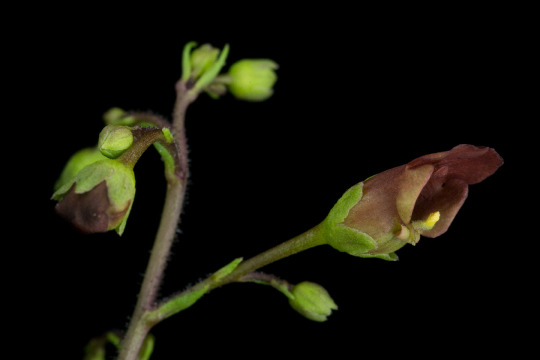


Scrophularia californica, in common name the California bee plant, is a native to - you guessed it - California! It occurs surrounding California's central valley and most frequently in southern California below the transverse ranges down into Baja California. From the order Lamiales, it can be recognized when not in bloom by its square stem and large and widely spaced tooth-edged leaves. Even when in bloom the flowers are small and easily overlooked where it grows in shade, but not by bees despite the coloration as bees do not perceive red flowers well.) Hummingbirds and small wasps are also noted visitors to the flowers and the foliage hosts several species of moth and butterfly larvae.
One quirky thing about S. californica is the flower morphology - the stigma is presented first and droops before the anthers are presented - not simultaneously. A fifth sterile stamen (staminode) is appressed to the upper surface of the tube, and from my reading, the reason for this is not yet known!
#canative#california native plants#UVIVF#glowingflowers#beeflowers#photography#botanical#biocommunication#365nm#neon
70 notes
·
View notes

